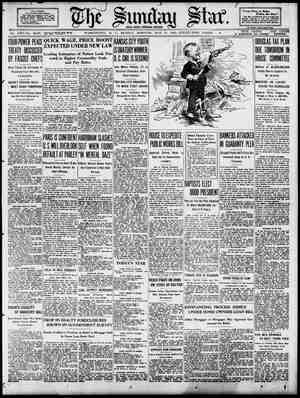Evening Star Newspaper, May 21, 1933, Page 66
You have reached the hourly page view limit. Unlock higher limit to our entire archive!
Subscribers enjoy higher page view limit, downloads, and exclusive features.
THE SUNDAY STAR, WASHINGTON, D. C, MAY 21, Little-Known . DramaticIncidents Connected With History-Making Flights. The first aviators to cross the Atlantic in non-stop flight made the perilous trip with the knowledge that if they did reach their goal they must crash on landing. The first westward flight across the Atlantic mhttoAmeHanshorsamnnwhoredb belonged under expert medical care. He um- - doubtedlysbortcnedhlslitebymnhngtbewlp. and he was fully aware of that fact. His death last year ended a colorful career. Yes, they're heroes, these airmen. ‘The world did not fai' to honor t:em when their courage Jed them to success. But the real proof of their bravery is found in the stories of what they did just before they winged their way into the built. ; Skeptics were waiting to say “I told you s0” 4f the plane landed in the water and drowned the audacious fiyer. But his preparations went on at Calais, France. The day before he expected to make the great flight, Bleriot was badly burned about the feet and legs in a gasoline explosion. Yet at dawn he hobbled to the plane on crutches, got in, and then tossed the crutches out. The remark about walking and flying was had begun. Jimmy Doolittle, America’s best-known test pliot, couldn’t throw away his crutches when Jimmy Doolittle, who with broken ankles, forced his rival down and made him run for cover. Glen Curtiss flew under the Eads Bridge, at St. Louis, with his left wing Luckled . . . From & peinting by Hal Morris, who meant that the South American government would buy military planes from America instead of Europe. Learning that Doolittle was planning to fly at the appointed time, his competitor made haste to steal the show. And upon learning of this Jimmy, through the eonnivance of friends, escaped from the hospital, in spite of his still unhealed ankles. They carried him to the field and, at his di- rection, strapped his plaster-incased ankles to the controls. The motor was warmed up, and up went Jimmy Doolittle, to overtake the flying salesman already in the air. HEN came the big show. Not as scheduled, but as Jimmy decided it should be put on. He drove at his adversary, forcing him to dodge or face collision in the air. Rolling, zooming, sideslipping, he literally drove the “enemy” to the ground. The pilot, on landing, ran from the field to escape his pursuer. The company Doolittle represented got the order. Salesman Doolittle went back to the hospital to have the broken ankles reset. They told Jimmy his adversary had com- alone across the ocean on May 21, 1927, just six years ago, while people were him,” he protested indignantly. or four inches—and he steered the with broken ankles in plasier casts, pro- ly as they did his bidding! cock and Brown, the former an Eng- and the latter an American, took off from Trepassey Bay, Newfoundland, in the Summer of 1920 for what proved to be the first “non-stop fight across the Atlantic, they faced danger and a mental hazard as well. and Greve had taken off on a similar than a month earlier, landed in mid- had been rescued by a ship. danger was a double one. Alcock and Brown might be forced down at sea with no friendly ship in sight. If they did get across they inevitably must crash on reaching their destination. That was because they had dis- carded their land'ng gear to allow for faster flight and for carrying of more gasoline. The landing gear was dropped into the sea After that They made the flight, landing in a bog near the wireless station at Clifden, Ireland. They were uninjured, but the plane was practically de- molished. Two courageous Frenchmen, Nungesser and Coli, made the same sort of arrangements for their disastrous attempt to make the first west- ward crossing of the Atlantic in an airplane, in the Summer of 1927. he could never make it . ... From & painting by Hal Morris. They deepped the landing gear of their Silver Bird as soon as it passed over the French coast, headed out t0 sea. Ne trace of them or of the Silver Bird has ever been discovered, though many searches have been made. . , t00, there's the matter of Byrd's flight across the Atlantic, from New York teo Moreover, it started in the face of unfavor- able weather prospects. Byrd was tired of wait- Baron von Huenefeld, Capt. Koehl a Fitsmaurice. e The baron, who contributed largely to the financing of the expedition, actually was in pain spectacular flight of Lindosrgh from New York to Paris needs little comment. Every move following the takeoff from Roosevelt Field was faithfully reported. But how about the preparations.
